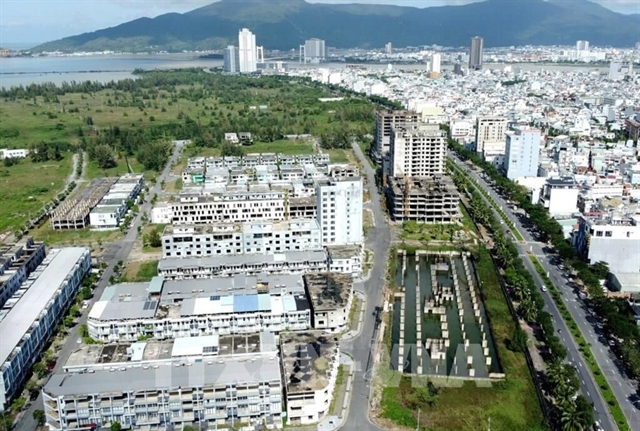 Business Beat
Business Beat


|
| Illustration photo. Land valuation still faces multiple bottlenecks. — VNA/VNS Online |
Compiled by Yến Vy
HÀ NỘI — After more than a year of implementation, the 2024 Land Law has revealed numerous shortcomings, among which land valuation stands out as a 'backbone' factor determining the effectiveness of many policies related to land recovery, compensation, resettlement and land use rights auctions.
To ensure that policies are implemented effectively, fairly and sustainably, it is urgent to amend and supplement the Land Law, particularly regarding the land valuation mechanism.
The 2024 Land Law was expected to address the limitations of the 2013 Land Law, especially in determining land prices that are more in line with the market, ensuring fairness for landowners whose land is acquired and facilitating investment projects. However, the implementation has shown that many bottlenecks related to land valuation need to be resolved quickly.
Experts have pointed out that for a long time, the land price table was set lower than the actual market prices, creating distortions in land compensation. The 2024 Land Law officially eliminates the land price framework and stipulates that the land price table will be set annually, with hopes to adjust prices more timely and in accordance with actual conditions.
However, in some localities, the land price table is still set much lower than the actual market value, leading to significant differences between compensation prices and the market sale prices of land for development projects.
This has led to complaints, public resistance and enterprises having to carefully consider their financial plans when participating in projects.
The Hanoi Department of Agriculture and Environment reported that, according to Article 159 of the 2024 Land Law, the starting price for land use rights auctions for land plots with invested infrastructure must be determined based on the land price table.
However, in many areas, the land price table is still lower than market prices, insufficient to cover the costs of investment, site clearance and land development.
In theory, the 'specific land price' is set by authorities at the time of land allocation or transaction and is supposed to reflect the market more accurately than the general land price table. However, in practice, determining specific land prices is very difficult.
Setting these prices requires many factors such as location, legal status, infrastructure, development potential, but the current mechanisms and methods for specific land valuation are not clear, and still rely heavily on the experience of appraisers.
Even the timing for determining specific land prices is not standardised. Additionally, the overlap of authorities and the lack of clear jurisdiction between localities often leads to disputes and complaints between citizens and government bodies.
This is one of the reasons why many localities are still hesitant to widely apply specific land prices, and when they do, it often leads to questions or public reactions. Furthermore, the legal documents guiding the implementation of the 2024 Land Law are still slow to be completed, causing localities to stall in applying land valuation methods.
These practical issues are creating bottlenecks that prevent the 2024 Land Law from fully realising its expected benefits.
Recently, Deputy Prime Minister Trần Hồng Hà chaired a meeting to report on feedback from Government members on the Draft Law amending and supplementing several articles of the 2024 Land Law, urging ministries, agencies, and associations to focus on analysing and discussing the issues that need urgent amendment to resolve bottlenecks that hinder socio-economic development, and to address issues with the land price table's market-based approach.
Relieving pressure
A difficult reality is that land prices in many regions are rising, especially in expanding urban areas. When a project takes several years to complete, if land prices are determined once based on the land price table or an initial specific price, investors may suffer losses if the land price increases significantly during the project.
Furthermore, if landowners are compensated based on a price lower than what companies could make by reselling the land, it could lead to feelings of 'unfairness'.
On the other hand, allowing land prices to be adjusted based on market prices during project implementation could lead to price inflation, as parties may collude to artificially raise land prices for profit.
As a result, many enterprises and experts have pointed out that the current land valuation method still carries risks and does not fully ensure fairness.
Ngô Gia Cường, director of Vietnam Appraisal and Inspection Co.Ltd (VAI), noted that when constructing the land price table, it is almost impossible to apply valuation methods as prescribed for land used for production or commercial services, as these must be interpolated based on percentages of residential land prices.
Many localities still use this interpolation method for land price tables, showing that the land price appraisal boards cannot properly implement the regulations of the Land Law, which requires land prices to be determined using official land valuation methods (none of which allow interpolation).
This means that even though the 2024 Land Law has removed the land price framework, there is still a risk that the land price tables for 2026 could repeat this limitation.
Separating and adding a distinct set of principles for land valuation when building land price tables, different from the market-based principles used for determining specific land prices, would help align the policy with theory and prevent policy volatility, said Cường.
Adding specific principles for constructing land price tables would also provide a clear legal basis for localities to have the authority and flexibility to build land price tables, stabilising tax revenues without causing significant fluctuations for the affected parties.
Establishing land prices in land price tables separately from market prices would stabilise the target groups, while ensuring that the prices used for determining financial obligations were not affected by the volatile, cyclical, and hard-to-predict fluctuations of the Vietnamese real estate market, added Cường.
Dr Nguyễn Thường Lạng, senior lecturer at the National Economics University, remarked that an important first step was to adjust the primary land price, which was the price set by the government when land is first allocated.
The valuation should not be entirely based on market prices. Instead, the primary land price should be set at a favorable level to incentivise businesses to invest and develop, rather than at a high level aimed at maximising budget revenues.
“If the primary land price is set too high, it will not only increase input costs for businesses, but it will also push up the land price market as a whole, putting pressure on the entire economy,” said Lạng.
Additionally, he proposed that land price regulation should rely on a framework of reference prices, differentiated by region and development goals.
Moreover, the State should proactively use various tools to regulate land prices to ensure transparency, fairness, and effectiveness.
Land auctions should be reasonably controlled to prevent price inflation, distorting the market. The regulatory tools must balance the interests of the government, businesses and citizens.
These tools should not only include administrative measures such as planning, pricing, and land-use limits, but also economic tools like taxes, interest rates, investment incentives, and other fiscal policies. — VNS